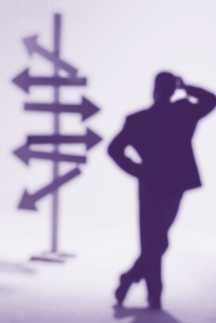
http://www.dbsasgv.org/wp-content/uploads/2017/11/Mood-Disorders-1-1.pdf
In any given year, nearly one in 10 American adults will suffer from a mood disorder. These illnesses involve changes in mood that affect daily life. They include major depressive disorder, dysthymia (persistent, low-grade depression) and bipolar disorder (episodes of “low” mood that alternate with episodes of “high” mood or unusual levels of energy or activity). People with mood disorders might have trouble with work life, family life and social life, or they might have difficulty simply getting through the day. While most mood disorders have depression in common, only in bipolar disorder are there mood swings of depression and periods of hypo-mania (if the bipolar disorder is mild) or mania (if severe). It’s important to know the difference between the different types of depression, because different types require different treatments.
What is Depression?

Depression is more than just feeling sad. It’s a serious—but treatable—medical illness characterized by an imbalance of brain chemicals called neurotransmitters and neuropeptides. It’s not a character flaw or a sign of personal weakness. Just like you can’t “wish away” diabetes, heart disease or any other physical illness, you can’t make depression go away by trying to “snap out of it” or “pull yourself up by your boot straps.” Early in people’s experience of a mood disorder, their episodes of depression often follow stressful events like marital problems or the death of a loved one. While depression sometimes runs in families, many with the illness have no family history of depression. The exact causes of depression—and mood disorders in general—still are not clear. What we do know is that both genetics and a stressful environment, or life situation, contribute to the cause of mood disorders. Usually, it’s not one or the other, but a combination of both.
An estimated 18 million or more Americans experience a major depressive episode each year. It’s the leading cause of disability for people ages 15-44 in the United States. And for the majority of people, it is a recurrent illness which can become chronic (lasting for more than two years).
People who have recurrent episodes of major depression are sometimes said to have unipolar depression (or what used to be called “clinical depression”), because they only experience periods of low, or depressed mood. Those living with chronic, low-grade depression have what is called dysthymia. When people experience both dysthymia and major depression, they are sometimes said to have double depression. In addition, mood disorder symptoms can arise after a woman gives birth (postpartum depression). And they also can be accompanied by psychosis (psychotic depression) and can occur during the winter season (seasonal affective disorder, SAD). However, what most mood disorders have in common are major depressive episodes.
Signs and Symptoms of Major Depressive Episodes
■ Prolonged sadness or unexplained crying spells
■ Significant changes in appetite and sleep patterns
■ Irritability, anger, worry, agitation, anxiety
■ Pessimism, indifference
■ Loss of energy, persistent lethargy, fatigue
■ Feelings of guilt, worthlessness or helplessness
■ Inability to concentrate, difficulty making decisions
■ Social withdrawal
■ Inability to take pleasure in activities or hobbies once pleasurable
■ Unexplained aches and pains, or aches and pains that don’t ease with treatment
■ Recurring thoughts of death or suicide
What is Bipolar Disorder?
Bipolar disorder is another type of mood disorder, different from unipolar depression. People diagnosed with this illness have mood swings involving both lows (bipolar depression) and highs (called mania if severe or hypomania if mild). It’s estimated that two to five percent of American adults will suffer some form of bipolar disorder.
When people go through the lows of bipolar disorder (bipolar depression), their symptoms are very similar to those that someone with unipolar depression might have. In a severe case of bipolar disorder, people experience extreme highs known as mania.
Signs and Symptoms of Mania
■ Restlessness, increased physical/mental activity and energy
■ Heightened or “high” mood, exaggerated optimism and self-confidence
■ Excessive and extreme irritability, aggressive behavior
■ Decreased need for sleep without feeling tired
■ Grandiose thoughts, inflated sense of selfimportance and abilities
■ Racing speech, racing thoughts, flight of ideas
■ Impulsiveness, poor judgment, distractibility, inability to concentrate
■ Reckless behavior like spending sprees, drug use, sexual indiscretions
■ A period of unusual or uncharacteristic behavior
■ Denial that anything’s wrong
■ In the most severe cases, delusions and hallucinations
Some people with bipolar disorder can experience what’s called a mixed state. When this happens, people have symptoms of both depression and mania at the very same time. Those who have had a mixed state often describe it as the very worst part of bipolar disorder. They have all of the negative feelings that come with depression, but they also feel agitated, restless and activated, or “wired.”
Just as there are different types of depressive disorders, there are also different types or patterns of bipolar disorder, such as rapid cycling (more than four mood episodes in one year), cyclothymia (mild highs and lows), and bipolar not otherwise specified (NOS). The two most common types are bipolar I and bipolar II.
Bipolar I disorder used to be called “manic depressive illness.” It’s the “classic” form of the illness in which the individual experiences extreme highs (mania) and lows (bipolar depression) in mood. In contrast, people affected by bipolar II disorder don’t have such extreme highs or manic symptoms. Instead, they experience just mild highs, or hypomania. The symptoms of hypomania are similar to those of mania, but much less intense and severe. In fact, people who experience hypomania might not feel impaired at all. For example, people who are hypomanic might be more talkative than usual, but their speech makes sense and seems to follow a logical pattern. They don’t experience hallucinations or delusions. Hypomania might make them appear more energetic or productive. But if their illness goes untreated, they can become severely depressed. Those with bipolar II disorder tend to have more depressive episodes than those with bipolar I.
In both types of the illness, though, bipolar depression (the lows) is more common than mania or hypomania (the highs). Bipolar depression is also more likely to be accompanied by disability and suicidal thinking and behavior. One thing that all types of bipolar disorder have in common is this: people with the illness spend the majority of their symptomatic lives “below baseline” … in the low, depressed phase.
What’s the Difference Between Unipolar and Bipolar Depression?

The symptoms of unipolar depression and bipolar depression are very similar. The main difference is that someone with unipolar depression doesn’t experience the highs periods of mania (if severe) or hypo-mania (if mild). And this is extremely important, because the preferred treatments of the two can be quite different.
Why Bipolar Disorder is Often Misdiagnosed
Because the illness has such a wide range of symptoms and behaviors, bipolar disorder can be misdiagnosed. It’s possible for bipolar disorder to “hide” and go unnoticed, because patients and/or providers don’t recognize the highs. Many people actually see these highs as an idealized norm. To complicate things further, it might be several years before a patient even experiences the highs.
Many people who are correctly diagnosed with bipolar I disorder were diagnosed during a crisis associated with full-blown manic behavior. But hypomania—the mild highs experienced by those with bipolar II disor-der—is especially difficult to recognize. Hypomania might not have negative side effects for the individual at first. And sometimes, people actually function better during a hypomanic episode. They often see themselves as being more productive.
Most people with bipolar disorder aren’t inclined to seek psychiatric treatment when they’re experiencing the highs of mania or hypomania. In fact, many don’t even realize that the highs aren’t normal. Many folks would like to keep their highs, because they feel outgoing, extroverted and friendly … like “the life of the party.” The problem, though, is that periods of depression eventually follow most highs. After episodes of hypomania or mania, people begin to feel fatigued and down. They become aware that they’re gradually slipping into depression. It’s during this “low” phase of bipolar disorder—bipolar depression—that most people seek professional help and receive a diagnosis. In fact, the majority of people with bipolar disorder in the outpatient setting are initially seen for—and diagnosed with—unipolar depression. The highs they’ve experienced are ignored.
It’s estimated that many people with bipolar disorder wait about 10 years between their first contact with a mental health provider and receiving the correct diagnosis. Folks who have bipolar disorder along with alcohol or drug use problems often go undiagnosed for even longer: 15-20 years. Studies show that, in the primary care setting alone, 10-25 percent of people diagnosed with unipolar depression may actually have bipolar disorder. The percentage is even higher among patients in the psychiatric setting. And incorrect treatment for bipolar disorder can actually lead to episodes of mania and other problems.
What’s Different about Treatments for Bipolar Disorder and Unipolar Depression?

Treatment for bipolar disorder usually includes counseling (psychotherapy) and a medication called a mood stabilizer. Counseling helps people learn how to live with, or manage, the leftover symptoms of the illness. And mood stabilizers prevent, or delay, future episodes of depression, hypomania or mania. Often, other medications like traditional antidepressants are also necessary.
But for some people with bipolar disorder, taking a traditional antidepressant alone, or along with a mood stabilizer, can make the illness worse by causing the symptoms of hypomania to return. (This can happen to people with unipolar depression, too. Such cases, though, aren’t very common.) Antidepressants can sometimes also make bipolar depression worse by causing suicidal thoughts. If that happens, the traditional antidepressant should be discontinued immediately.
So that these things don’t happen, it’s important to know whether someone’s depression stems from bipolar disorder or is instead unipolar depression. For that reason, it’s important to see a mental health provider who has experience distinguishing between “regular” unipolar depression and bipolar depression. With a thorough medical and psychiatric history (including any possible manic or hypomanic symptoms), as well as a comprehensive physical exam, these providers can reduce the number of misdiagnoses. And this means people get the treatment they need … and get it sooner.
How Do I Know If I Have Unipolar or Bipolar Depression?
Even with excellent health care, sometimes bipolar depression can still be mistaken for—and misdiagnosed as—unipolar depression. Why? Because many people with bipolar disorder only have recurrent episodes of depression during the early years of their illness. The hypomanic or manic episodes often don’t start right away.
When people are misdiagnosed, treatment might seem to work for only a short time, and then the mood episodes return. Or maybe treatment doesn’t work at all. If you or a loved one has received more than one adequate course of treatment for unipolar depression (including both counseling and medication), and haven’t responded, ask your doctor to consider whether you may actually have bipolar disorder. Even the best and most experienced clinicians might make an incorrect diagnosis at first, because the highs don’t always occur during the first few years of the illness. How you progress in your treatment will help you and your provider determine the next steps for your recovery.
No clinician or tool can diagnose unipolar depression or bipolar disorder with 100 percent accuracy. Be patient with yourself and your health care provider.
If you’re not getting better, make sure your provider knows this. Illnesses are sometime impossible to diagnose right away. Research does point to some clues that what’s mistaken for depression might actually be bipolar depression—the depression phase of bipolar disorder. Studies show that people incorrectly diagnosed with unipolar depression often have
■ the perception that “people are unfriendly”
■ a co-occurring anxiety disorder
■ a recent (in the last five years), initial diagnosis of unipolar depression
■ a family history of bipolar disorder
■ legal troubles

These signs could indicate that providers need to reevaluate your initial diagnosis, as well as screen for bipolar disorder. To do this, your doctor might ask you to take a short survey, like the Mood Disorder Questionnaire (MDQ) found on DBSA’s website at www.DBSAlliance.org/MDQ. The MDQ is a series of questions designed to help your health care provider distinguish unipolar from bipolar depression. If you’re not responding to your treatment, you might want to fill out the questionnaire and take it to your next visit. Remember, only qualified health care providers can diagnose you. Your job is to make sure that they have all of the information they need to treat you. Often, the best way to get quickly and accurately diagnosed is to go to a health care provider for an evaluation with a loved one or significant other, someone you trust and who can shed light from a different perspective. Having someone else with you during a first-time evaluation improves your chances of getting the very best diagnosis and treatment. It also helps your loved one learn about, and understand, your illness.
Keep in mind, though, that if you’re not responding to your treatment, it doesn’t necessarily mean you’ve been misdiagnosed. If your treatment isn’t working but you haven’t had any symptoms of mania or hypomania, it might be that you simply need a change in your dosage and/or type of medication or psychotherapy. Recent studies show that many people who don’t start feeling better after one adequate course of antidepressants will benefit from a different medication.
How Do I Talk to My Doctor About My Diagnosis and Treatment?
Many people are reluctant to talk to their doctor if they think they might have been incorrectly diagnosed or treated. They’re afraid their doctor will be offended or think they’re questioning his/her expertise or authority. It’s important to remember, though, that the best treatment results from a partnership between provider and patient. This means that both of you are working together to achieve the best possible results. The provider is responsible for gathering and analyzing the necessary information. And you are responsible for providing that information. The provider may be the expert on the illness, but you are the expert on your life.
If you think you might have been incorrectly diagnosed or treated, talk with your provider about it. Be sure to include the specific reasons that you think this. A good clinician will listen to you and address your concerns. The fact that you have concerns might mean that you would benefit from further information or changes in your treatment plan.
Hope, Help and Support
Depression and bipolar disorder are complicated illnesses with complex and challenging symptoms. But it’s important to remember that you’re not alone, and that there is hope, help and support. These illnesses are treatable, and treatment does work. The majority of people who get diagnosed and treated experience some degree of recovery. Work together with your health care providers to come up with the treatment plan that is best for you. You might also consider attending a DBSA support group, where people with mood disorders and their loved ones can share experiences, discuss coping skills and offer hope to one another. In time, with treatment and support, you’ll see that recovery is possible.

Please help us continue our education efforts.
We hope you found the information in this brochure useful. To help us continue our eduction efforts, please fill in and mail or fax the donation form below, call (800) 826-3632 or visit www.DBSAlliance.org.
DBSA is a not-for-profit 501(c)(3) Illinois corporation. All donations are tax deductible based on federal and state IRS regulations. Consult your tax advisor for details. All information is held in strict confidence and will never be shared with other organizations. Thank you for your gift!
We’ve been there. We can help.
Depression and Bipolar Support Alliance
The Depression and Bipolar Support Alliance (DBSA) is the leading patient-directed national organization focusing on the most prevalent mental illnesses. The organization fosters an environment of understanding about the impact and management of these life-threatening illnesses by providing up-to-date, scientifically based tools and information written in language the general public can understand. DBSA supports research to promote more timely diagnosis, develop more effective and tolerable treatments and discover a cure. The organization works to ensure that people living with mood disorders are treated equitably.
Assisted by a Scientific Advisory Board comprised of the leading researchers and clinicians in the field of mood disorders, DBSA has more than 1,000 peer-run support groups across the country. Nearly five million people request and receive information and assistance each year. DBSA’s mission is to improve the lives of people living with mood disorders.
Depression and Bipolar Support Alliance
730 N. Franklin Street, Suite 501 Chicago, Illinois 60654-7225 USA Phone: (800) 826-3632 or (312) 642-0049 Fax: (312) 642-7243 Website: www DBSAlliance org
Visit our updated, interactive websitefor important information, breaking news, chapter connections, advocacy help and much more.
This brochure was reviewed by DBSA Scientific Advisory Board member Joseph R. Calabrese, MD, professor of psychiatry at Case Western University and director of the University Hospitals of Clevelands Mood Disorders Program. DBSA Director of Scientific Affairs Brenda Bergeson, MD, also reviewed this publication.
DBSA does not endorse or recommend the use of any specific treatment, medication or resource mentioned in this brochure. For advice about specific treatments or medications, individuals should consult their physicians and/or mental health professionals. This brochure is not intended to take the place of a visit to a qualified health care provider.
MD1208
©2008 Depression and Bipolar Support Alliance Models used for illustrative purposes only
